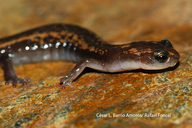|
Chiropterotriton multidentatus (Taylor, 1939)
Toothy Splayfoot Salamander | family: Plethodontidae subfamily: Hemidactyliinae genus: Chiropterotriton |
 © 2008 César L. Barrio Amoros (1 of 17) |
|
|
|
Description Variation: Tail length varies from 28-50 mm in males and 31-37 mm in females, with larger salamanders having longer tails (Dodd and Brodie 1976). Distribution and Habitat Country distribution from AmphibiaWeb's database: Mexico
Life History, Abundance, Activity, and Special Behaviors Trends and Threats Relation to Humans Possible reasons for amphibian decline General habitat alteration and loss Comments The phylogentic position of C. multidentatus is still very uncertain due to the lack of new specimens and the fact that previous taxonomic work was conducted before genetic sequencing and immunological comparisons techniques. Sequence divergence between haplotypes places C. multidentatus as most closely related to C. cracens (Parra-Olea 2003). Darda (1994) tentatively assigned specimens from Rancho del Cielo, Tamaulipas to this species, but the specimens from Rancho del Cielo assigned to C. multidentatus may represent a different species Rabb (1958). There are two separate populations of C. multidentatus, one from Hidalgo and another from Tamaulipas. They differ from one another in feet morphology, body size, dentition and coloration, but are still identified as the same species Rabb (1958). The occurrence of gaps along the Sierra Madre Oriental might mean that the habitat of C. multidentatus was once widespread but is now patchy, which would explain the genetic variation between the two groups (Darda 1994).
References
Darda, D. M. (1994). "Allozyme variation and morphological evolution among Mexican salamanders of the genus Chiropterotriton (Caudata: Plethodontidae)." Herpetologica, 50, 164-187. [link] Dodd, C. K. Jr., and Brodie, E. D. Jr. (1976). ''Defense mechanisms of neotropical salamanders with an experimental analysis of immobility and the effect of temperature on immobility.'' Herpetological Monographs, 32, 269-290. Parra-Olea, G. (2003). "Phylogenetic relationships of the genus Chiropterotriton (Caudata : Plethodontidae) based on 16S ribosomal mtDNA." Canadian Journal of Zoology, 81, 2048-2060. [link] Rabb, G. B. (1958). ''On certain Mexican salamanders of the plethodontid genus Chiropterotriton.'' Occasional Papers of the Museum of Zoology, 587, 1-37. Stuart, S., Hoffmann, M., Chanson, J., Cox, N., Berridge, R., Ramani, P., Young, B. (eds) (2008). Threatened Amphibians of the World. Lynx Edicions, IUCN, and Conservation International, Barcelona, Spain; Gland, Switzerland; and Arlington, Virginia, USA. Originally submitted by: Samantha Cherry, Kimberly Brown, and Daniela Palmer (first posted 2011-04-20) Edited by: Brent Nguyen (2012-03-19) Species Account Citation: AmphibiaWeb 2012 Chiropterotriton multidentatus: Toothy Splayfoot Salamander <https://amphibiaweb.org/species/4035> University of California, Berkeley, CA, USA. Accessed May 29, 2025.
Feedback or comments about this page.
Citation: AmphibiaWeb. 2025. <https://amphibiaweb.org> University of California, Berkeley, CA, USA. Accessed 29 May 2025. AmphibiaWeb's policy on data use. |




 Raffaëlli Account
Raffaëlli Account Map of Life
Map of Life